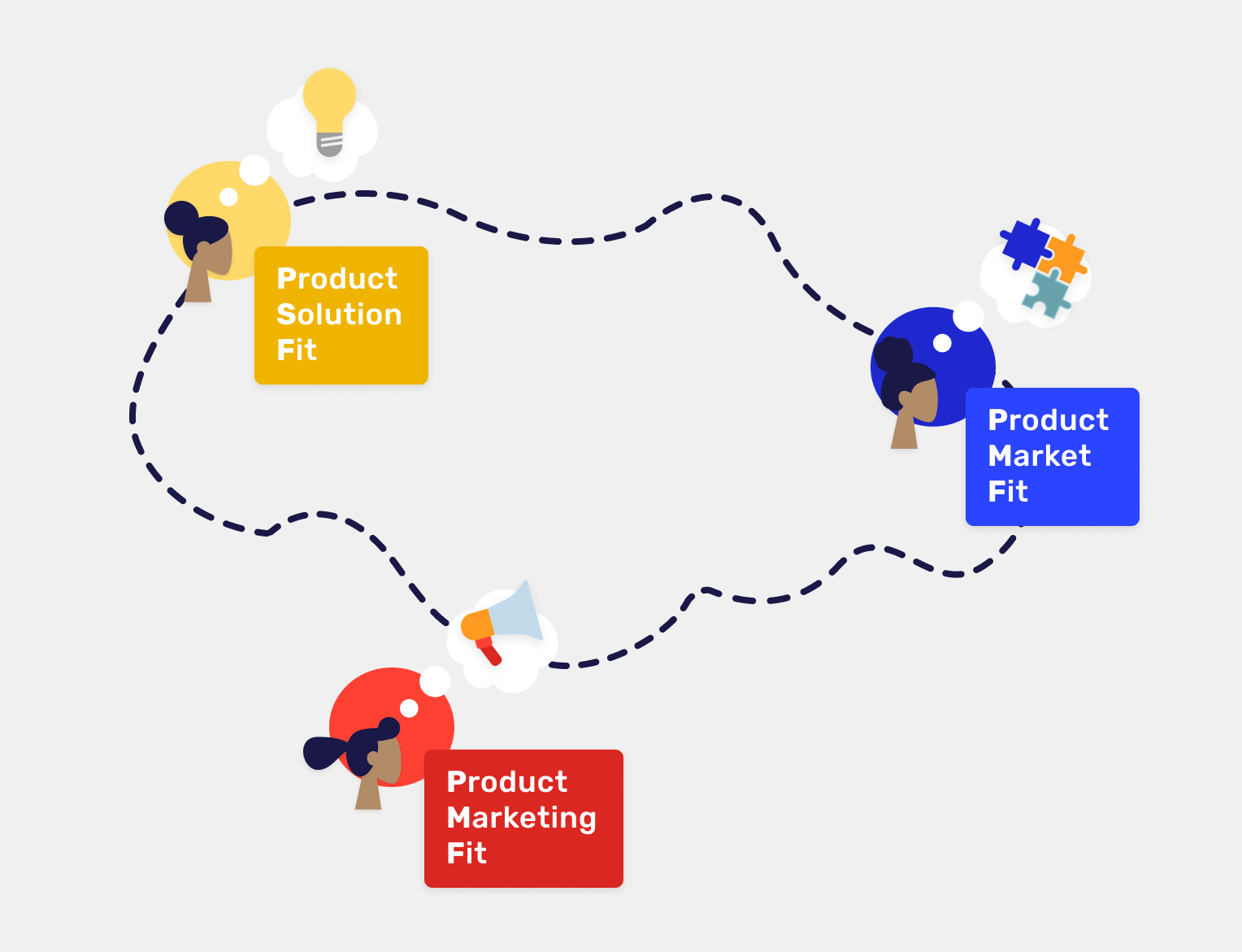
As if PMF wasn’t enough of a concept to contend with, now there’s PSF and PMingF too.
But what are these? What do they mean? How do they fit together? And aren’t they really just new names for things we’ve been doing for decades anyway?
First of all, let’s get the definitions out of the way.
Well, as close to definitions as possible. Because, as any entrepreneur will know, the exact definitions are likely to change based on the product you’re building and the market you’re operating in.
Definitions and differences…
Problem/Solution Fit (PSF)

You’re well-positioned to solve a complex problem that haunts the customer daily, you’ve also figured out what strong triggers and emotional messaging to use to affect the customer, and have found the appropriate channels that will increase the probability of adoption.
The solution may be one of a kind, solving an issue that has never been taken care of; or the problem might already have an existing solution, in which case, your idea manages to solve it in a unique way. A solution will have a higher chance of being adopted if the method and impact are unparalleled in the market.
For a handy visual guide to achieving PSF, take a look at this canvas. It’s a unique template that helps to identify customer behaviour and take into consideration the context around it, offering a broader perspective that will increase your chances of finding the best solution. Not only will it help you solve complex problems that fit with what your customers are saying, but it will also help refine your communication strategy, so it’s a good tool to have around!
Product/Market Fit (PMF)

Achieving PSF is obviously not enough, there’s no point in creating the perfect product if you can’t produce a decent revenue or scale. That’s where PMF comes in.
You’ve spoken directly with your target segment, identified the strengths and weaknesses of your product, acted on feedback and tested until you’ve reached the best and most profitable version of your prototype. It’s become clear that your product is superior to those in the same vertical you’ve chosen, and you’ve managed to hone in on a niche of that vertical that allows you to be laser focused with your next steps.
“Why can’t I handle more than one vertical though?” I hear you ask.
Operating within one narrow vertical and becoming the industry expert, instead of the factotum that tries to manage diverse areas of responsibilities, is a must. Even if your product has the potential to appeal to many different industries, it’s difficult, if not impossible, to sell all the different use cases at once, especially at the very start of your journey. So focusing on a single slice will get you to PMF easier and quicker.
But how on earth do you know when you’ve achieved it?
Imagine you’re buying a house. You know that you want three bedrooms, a garden, and enough room for a pony or a swimming pool. But there’s also that ‘je ne sais quoi’ that you need and that you can’t quite articulate. But when you actually walk into that house and get that ‘wow’ feeling (or whatever you want to call it), you just know, there and then, that’s it.
It’s the same with PMF. It’s that moment in which you finally feel the tug of the market. The effects of PMF are unmistakable, once your product starts flying off the shelves, you completely lose control and find that your product fits snugly in the market as if they were made for each other.
If you’re uneasy with the vagueness of this approach, then you can of course apply a calculation to discover if you’ve reached PMF. For example, with this spreadsheet.
But the issue is that it’s not the same for everyone. Yes, you read it right, PMF cannot be properly defined because it’s different for every business/product.
Take Enterprise PMF, for example, there are many factors to consider: the strong risk aversion from large Enterprise customers, the difference between the individual with purchasing power and the actual user, the need to tailor your product to the enterprise’s needs. The structure of an enterprise is as complex as the process of creating a product for one.
Product/Marketing Fit (PMingF)

It’s difficult to understand if PMingF is just a bit of hype. It could be considered just another name for the ‘positioning’ part of PMF, which focuses on the perception of the market but is quite often overlooked.
Endless reiterations of your product will do you no good if you aren’t able to deliver it to the right crowd - what’s the point of having great bait if you don’t know how, where, and when to cast your fishing rod, or you don’t know if the fish even eat this type of bait?
A great way to discover the perception of the market is to conduct surveys like the one devised by Superhuman. Knowing if your product is having an effect on your customer’s life is crucial and will help you understand what to change - whether it be the product or the target segment.
Well done, that’s the first hurdle cleared. But whilst knowing what the client thinks is good, it’s unfortunately not enough. It’s essential to know your target audience like the back of your hand. A standard marketing strategy remains a large part of this, but you have to go a lot
deeper to find success. Think of what channels they normally use, how they choose products, and what would make them switch to your solution.
And finally, if you had to choose between PMF and PMingF, where should you focus your attention? This twitter poll suggests that PMF is where it’s at!
So how do they differ… if at all?
The differences are subtle, as the three are closely entwined and together create a continuous feedback/iterative loop.
PSF is when you know that you’ve landed on a significant problem that can be fixed with a potential solution; PMF can only happen when there is a strong demand for your product, which resonates with the market and can be turned into profit; PMingF is essentially the positioning of your product and how you interact with the market and navigate within it.
The Continuous feedback loop
To ensure you get a successful feedback loop going, it’s crucial to keep speaking to customers about the problem you’re trying to solve, as you’ll eventually find out what it is they need and what additional features or functionalities you need to build.
Communication and testing are your most valuable tools.
Talking with customers, in addition to A/B and UX testing, will also reveal the weaknesses and strengths of your product, essentially allowing you to discover what works, what’s broken, and what’s missing.
When collecting feedback though, it’s important to keep in mind that not all feedback will come from a target customer. Basing the next iteration of your prototype entirely on the needs of someone who wasn’t an intended target may divert you from the product’s original utility. So be sure you keep your target in mind.
In the event that a considerable amount of people outside of a target segment start providing feedback and expressing their needs, you should consider shifting the scope. The power of pivoting is not to be underestimated.

The importance of pivoting
As you go through this feedback loop, you’ll inevitably need to ‘pivot’ - whether that’s the product itself, or your route to market, or your target audience. Pivoting is a shift in strategy that seeks to find a new approach after having analysed direct or indirect feedback.
Instagram is a great example of this as it started out as a geo location-based check-in service like FourSquare. They soon came to the realisation though that users were using images the most, so that’s when they stripped the app bare and left only the most utilised features.
When Yelp, the popular crowd-sourced review forum, was created, it was intended to be an email-based referral network. The idea was rejected by investors and didn’t attract much attention, but the founders noticed that users were using the “Real Reviews” feature that allowed them to write unsolicited reviews. After being redesigned around this single feature that caught on, Yelp’s popularity soared. They had found their PMF.
It’s difficult to get PMF on your first try, even the biggest brands have had to pivot at the beginning of their journey. Pivoting never stops though, perseverance is a great quality to have but you must also know when to let go if your product has reached a dead end.
How do you know when you’ve ‘hit the fit’?
It may seem strange in a business environment, but hitting the fit is an art, not a science.
It’s widely thought that if 40% of users would be ‘very disappointed’ if your product ceased to exist, then you’ve reached your goal. But it’s actually quite subjective due to differences in industries and products.
PMF, in its most essential form, is about finding a good market with a problem to solve and creating a product that resonates inside this market - exponential growth is a clear sign that you’ve made it.
To be able to assess this growth, it’s important to break down the metrics into different phases and move from one phase to the next when you’ve ‘hit the fit’.
Discover if people are visiting your landing page and signing up, ask yourself if they’re showing interest.
Is the product solving the right problem? Are people using it and getting value out of it?
Then comes the sales; are people actually paying for your product? No revenue means no PMF.
Test, test and test again.
The tug of the market is surely a noticeable sensation that will probably leave you gasping for air, smiling and thinking about the enormous amount of work that has finally paid off.
The Non-Technical Founders survival guide
How to spot, avoid & recover from 7 start-up scuppering traps.
The Non-Technical Founders survival guide: How to spot, avoid & recover from 7 start-up scuppering traps.

